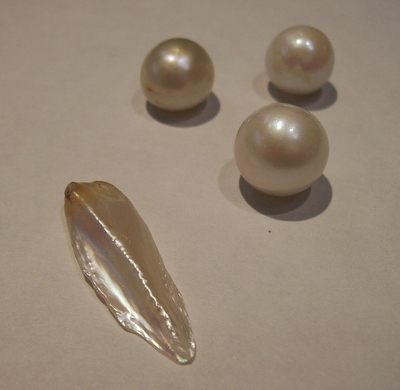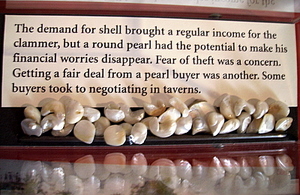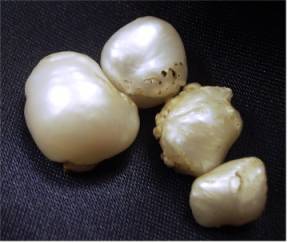|
Mississippi River Pearl Lake Pepin Pearls (Mississippi River) Within the main channel of the Mississippi, the relative scarcity of pearls in the Unios, and the greater preparation required for collecting the mollusks in the deep waters, retarded the fishery until the establishment of button manufacture afforded a market for the shell, this originating in 1891. When only a few mollusks are taken, they are readily opened with a knife to permit a search for the pearls. But where there are many, as in the Mississippi River, the opening is facilitated by heating. This cooking is a convenient method of opening the shells, but unquestionably it injures the quality of many pearls. In some instances when the shells open, the pearls fall out and descend to the heated iron bottom, where they are quickly injured. The surface of one exposed too long to the heat shows numerous minute cracks, which increase in number and size when subjected to changes of temperature. Some choice gems have in this manner been rendered almost valueless. If a jacket boiler, or one with a double bottom, were used, there would be less danger of injuring the pearls. Several fisherman have endeavored to devise mechanical methods for removing the pearls and thus avoid the painstaking search among the flesh tissues now necessary; but these contrivances have not proved satisfactory, and have not been employed except experimentally. Small and irregular pearls are not at all uncommon, but choice ones are decidedly scarce, and each one represents the destruction of thousands of mollusks.  Mississippi River Pearl Slugs Quantities of irregular and imperfect nodules know as slugs are collected, which sell for only a few dollars per ounce. In some sections of the Mississippi, the slugs are so very numerous that their aggregate value exceeds that of the choice pearls. In the Mississippi, the percentage of pearls found in a definite quantity of mollusks is less than in the tributary streams, yet the much greater quantity of shells collected raises the total yield to a very considerable amount. Pearling is subordinate and incidental to gathering the shells for manufacture. In that length of the river from St. Paul to St. Louis, a fair average yield to the fishermen is about fourteen dollars' worth of pearls and slugs to each ton of shells. Of course, this is not the individual experience, for a single Unio may contain a gem worth $5,000, and on the other hand several tons of shells may yield only a few cents' worth of baroques. A large number of choice pearls weighing over thirty grains each were found in a particular hundred mile region. The fishermen there in 1904 gathered pearls which ultimately sold for $300,000. A large percentage of the Mississippi River pearl are very irregular in form, many of them resembling dogs' teeth, birds' wings, the heads or bodies of different animals, etc. As a rule the freshwater pearls do not rank so high in value as those from oriental seas, since ordinarily they are not so lustrous. However, some of them have sold at very high figures. One Mississippi River pearl of 68 grains, found, in 1907, was marketed at $15,000.  Mississippi River Pearls While many pearls of fine luster and beautiful and regular form have been derived form these fisheries, it occasionally happens, in the case of pearls consigned to the city pearl dealer, that cracks, breaks for marks, which might detract from their value, are closed or removed, either by means of water or oil, the pearls having been kept in one or the other until a few moments before they were shown to the merchant. Pearls worth hundreds of dollars have sometimes shown breaks, and in one instance a Mississippi River pearl valued at $7,000 showed these cracks even a very short time after the sale. In many of the pearling regions of the Mississippi Valley, inquiry of almost any fisherman will result in his bringing forth from an inside pocket a small box padded with raw cotton and containing an assortment of pearls and slugs. While the highest prices were not received by the fishermen, there are many who have been so fortunate as to obtain $1,000 or more for a single pearl, and several have received double that amount. All sorts of stories of valuable finds are told in the pearling regions; stories of mortgages that have been released, of homes bought, of college educations secured from the proceeds of a single gem; but these tales are offset by the untold stories of the undermining of fine, strong character in awaiting the turn of fortune which never comes. The public is quickly apprised of the valuable finds, but it does not hear of the time and labor lost by the hundreds who are unsuccessful. Pearling excitement has many of the features of a mining craze. While a few are benefited, hundreds are made poorer, and in many instances reduced to absolute want. In many localities the pursuit yields far less profit than pleasure. (The above information about the Mississippi River pearl is from Kunz and Stevenson's popular book on pearls, 1908.) Lake Pepin Pearls |






